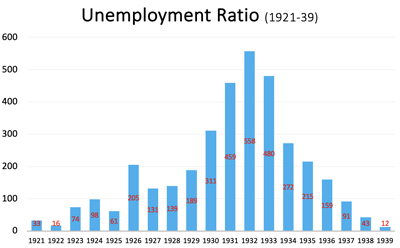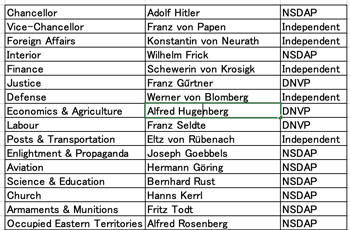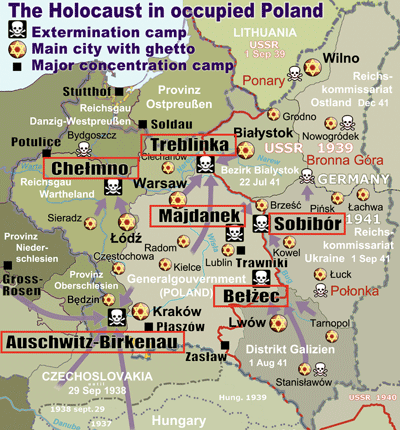>Top 5. Domestic & Foreign Policies of Nazi Regime:
- 1933/1/30-1945/5/8: Nazi Era
- Constitution of Weimal Republic became a mere ghost, and the society became a Nazi corpse; Hitler 's dictatorship could be divided into two parts:
- First half of the era: 1933/1/30-1939/9/1 (6 years & 7 months) until the start of WWII
- Second half of the era : 1939/9/1-1945/5/8 (5 years & 8 months)
- Transformation of Nazi Party;
- First cabinet: 3 Nazists and 8 conservatives
- after one year: 9 Nazists and 5 conservatives
- In particular, Geppels, Minister of Public Enlightenment and Public Relations intervened in the personal affairs of public broadcasting stations and suppressed media personnels who were critical of the administration.
- This was a 'Spiritual Mobilization' system by Geppels, who developed active propaganda while monitoring and controlling media and cultural activities.
- He enforced to imprint negative images by exaggerating, coloring, and forging only advantageous information, and transmitting negative information regardless of whether the enemy is true or false.
- The number of cabinet meetings were reduced, and the policies were practiced by Hitler's individual approvals. Hitler found no value in the consensus in the meetings; which rather increased the prestige of Hitler as the final decision-maker, while promoting anxieties of each minister and conflicts between ministries. (Divide & control policy by Hitler)
- 1933/5/1 Nazi Party members counted 2.49M, about 10% of men over 18 age. After that, the restrictions on joining the party were eased; in 1945 the number of party members reached 8.5M.
- 1933/7 the Law Against Founding New Political Parties made that the only legal party in Germany is Nazi Party, which hired 25K full-time staff nationwide, being a huge bureaucratic political organization.
- >Top Organization and Power Relations of Nazi Party:
- The top of organization is composed of 18 supervisors, or national leaders in charge of each section, which are, so to speak, equivalent to ministers.
- Regionally there are 32 Gauleiters (Regional leader) who have their own jurisdiction and responsibility for each local organization.
- However, Nazi Party did not have a party decision-making body such as the party's central committee or the Politburo. This is the reason why Hitler, who hated collective leadership and denied other power institutions. Consequently, majority domination by a large number of sub-leaders who compete each other under absolute Hitler and sometimes conflicted with each other.
- High-ranking political leaders are active in spoils activities with the aim of controlling the nation and the party, such as Göring, Minister of Aviation; Geppels, Minister of Enlightenment; Flick, Minister of Interior; Himmler, Schutzstaffel Leader; Robert Ley, Labor Front Leader; Hans Frank, Party Legal Director; Rosenburg, Party Foreign Director, etc.
- >Top General expectation for Nazi regime:
- Such background as the despair of German people who experienced the defeat of WWI, the collapse of the imperial government, astronomical inflation of the economy with the outbreak of the Great Depression captured the illusion of such expectations as the savior Hitler.
- Hitler's economic measure, particularly the unemployment problem was actually almost solved in four years after he took the administration. In 1933/1, 6M unemployment decreased to 0.91M in 1937. (>Fig.)
- Direct job creation: increased new employment for civil engineering projects such as autobahns, canals and bridges, and public projects such as national railways and postal services.
- Indirect job creation; economic stimulus measures such as automobile tax cuts, corporate tax cuts, and housing subsidies.
 - Hitler's government's original unemployment measures:
- Mandatory service activities for public works for one year from the age 18.
- Such labor service changed to military training.
- Promote incentive policy of home return of female workers; a special loan up to 1000 marks subject to home return without returning job, and the repayment was exempted by each quarter depending on the number of children (full exemption if four children were born). This policy was aimed to reduce the unemployment rate and increase the birth rate. In 1934 it enacted a law prohibiting double-income.
- Initially, unemployment measures were centered on the nonmilitary sector, but eventually employment was created through the development of military infrastructure. 1935/3 reintroduced the conscription system which contributed to reduce the number of unemployment.
- >Top Volksgemeinschaft (National or Racial Community):
- Aimed to promote national integration overcoming the internal divisions that have long characterized German society.
- 'Volk' has various meanings; ethnic group, nation as a component of a country, people as a sovereign, and general public of a society.
- However, he demanded that Jews as well as Marxism who advocated class struggle be excluded as an antisocial element.
- From Hitler's point of view, both the Treaty of Versailles and the Weimar Constitution were imposed as a result of the defeat of WWI. He particularly required people to commit service and self-sacrifice to the nation in order to transform the country capable of war.
- The criteria for who belong to the Volksgemeinschaft were not clear; many Nazists and members of Nazi-related organizations were regarded as core members of the national compatriot, where many people believed to be able to demonstrate pay for performance. The typical activities are:
- Nazi Party Conversion:
1933-38 the party conventions held in Nuremberg, southern Germany, at the end of each summer became a major pageant connecting Hitler, the Party, and the people, with more than one million participants from all over the country. There were many attractive events; 100,000 persons scale of march and mass games were shown.
- The main event of the party convention was Hitler's speech. Each convention, he showed the direction of the country on a particular subject; in 1933 the theme was 'Victory'; in 1935 when the conscription system was introduced, it was 'Freedom'; in 1934 he overcame Röhm's plot, he emphasized a great leader; in 1936 Germany proceeded in Rhineland, and the theme was ' Honor'; in 1937 when he achieved eradication of unemployment, it was 'Labor'; in 1938 when he realized the union with Austria, it was 'Great Germany', and in 1939 when the convention was canceled due to invasion to Poland, but the theme was scheduled to be 'Peace'.
- >Top Autobahn (automobile+road) construction:
The highway with a total length of 13,000 km was promoted as a part of measures against unemployment. The actual number of workers involved was about 60,000-100,000 a year, which was regarded as the main battlefield for eradicating unemployment, and the workers mobilized for construction were required to live in groups like military camp.
National car (Volkswagen) per each home was planed, but it was unsuccessful.
- Kraft durch Freude (KdF; Strength Through Joy)
Under the Nazi Government, the unions were disbanded and reorganized into the German Labor Front (Deutsch Arbeitsfront), where
workers and managers joined together. Labor-management negotiations were denied, and state trust officers instead set wages. The Strength Through Joy provided leisure and entertainment (theater, music, sports, travel, etc.) as a part of the Labor Front, and Nazi philosophy was promoted through these activities.
- Winter Relief Projects (Winterhilfswerk, WHW):
From October to March, on the second Sunday of every month, all the people were supposed to enjoy hot pot cooking, and donations of saved food expenses were encouraged.
- Recovery of the great power Germany:
- German diplomacy during the Weimar Republic, called modified diplomacy, had worked on a review of the Versailles system under internationalism, but there remained still several unsolved problems.
- Return of Saar Region to Germany, which was under the control of the League of Nations.
- Return of Polish Corridor to Germany, which was ceded to Poland.
- Realization of Merge of Germany and Austria.
- Restoration of German sovereignty in Rhineland, which was a demilitarized zone after the occupation of France.
- Hitler used two faces, a martialist and a pacifist. For the general public, he promised to comply with all international treaties, including the Treaty of Versailles. He emphasized that conflicts should be settled in a peaceful way, not by force. Foreign media praised Hitler's stance of pacifist, and UK Times also praised Hitler as a big-name politician.
- Konstantin von Neurath, the early foreign minister of Hitler's administration, was the veteran foreign minister of both the Franz von Papen government and Kurt von Schleicher government, and played a key role in soothing the vigilance of neighboring countries through the continuity of German diplomacy.
- However, Hitler welcomed the increasing movement within the Ministry of Foreign Affairs to promote a shift from a collective security policy based on multilateral negotiations to a bilateral alliance policy promised on military power.
- 1933/10 By withdrawing from the League of Nations, Germany escaped from the strict arms race under the Treaty of Versailles and proceeded with its arms race.
- 1934/1 Germany signed with neighboring Poland a comprehensive non-aggression pact, and confirmed the border with Poland. UK welcomed this negotiation, considering threat of possible approach of USSR to France.
- 1934/7 Prime Minister Dollfuss (Christian Social Party) outlaws the Austrian Nazi Party, but was killed by a coup d'etat. Hitler was accused of being involved in the murder and received international criticism.
- >Top UK and France had formed a siege against Germany with Italy, Austria, and USSR which joined the League of Nations, in order to protect the Versailles system and the Locarno Treaty (1925/10 the Collective Security Treaty of Rheinland)
- Scenario for German-UK Alliance:
France, which confronts Germany can collaborate with UK, Italy and USSR. However, UK is appeasing to Germany from its strategy against USSR, while Italy has an ambition for Abyssinia (Ethiopia), and USSR is skeptical of the Western powers.
- 1935/6 UK-Germany Navy Agreement was signed, with navy power UK 100 vs. Germany 35; this agreement meant to allow Germany to expand its arms race.
- 1936/3/7 Hitler sent troops to the demilitarized zone of Rhineland in line with Italy's invasion of Abyssinia. Hitler's bet brought a big victory, as the reaction between France and UK were not so intense. The league of Nations imposed sanctions on arms embargo on Italy which invaded Abyssinia, but Germany did not blame Italy and approached each other quickly.
- 1936/9 Hitler aimed for a self-sufficient system in his four-year plan of strategic supplies such as oil, rubber, and steel as well as promoting a large-scale arms race. German defense spending had reached half of its national budget.
- In 1936/7 in the Spanish Civil War, Hitler assisted Franco's army and formed the Berlin-Rome axis by approaching Germany and Italy. In 1936/11/25 Germany-Japan Anti-Comintern Pact was signed, then in 1937 Italy joined as an original signatory.
- >Top 1936/7 In the Spanish Civil War, Hitler assisted Franco's army and formed Berlin-Rome Axis by Germany and Italy, then on 1936/11/25 signed Japan-Germany Anti-Comintern Pact considering USSR as a hypothetical enemy. The following 1937/11/6 Italy joined, and Japan-Germany-Itary Anti-Comintern Pact was established.
- Hitler's War Execution Plan:
- 1937/11/5 Hitler invited Fritsch Army Commander, Bromber Defense Minister, Neurath Foreign Minister and Hermann Göring Air Force Minister to his office to disclose his plans for the coming war. In response, Fritsch, Bromberg and Neurath opposed and called for reconsideration. (Hossbach document, which was recorded at that time, was adopted as evidence of the war of aggression in the later Nuremberg Military Trial)
- In 1938/3 Hitler dismissed the conservative elite who had supported Hitler, and replaced them with more faithful Reventrop, etc. as successors.
- 1938/9 German troops invaded Austria, proclaiming annexation of Germany with almost no resistance. After that, Hitler requested Czechoslovakia to cede Sudetenland region, which had many German residents. UK Prime Minister Neville Chamberlain nevertheless did not change the appeasement policy. Hitler, Chamberlain, Mussolini and Daradia (France) met in Munich and approved to cede Sudentenland region to Germany.
- Half a year later, Germany invaded the Protectorate of Bohemia and conquered Prague, crating a puppet government in Solvakia. Then Hitler requested Lithuania to return the Memel region and Poland to return Danzig and the Polish Corridor to Germany.
- At this point, UK abandoned at lat its policy of appeasement against Germany. On 1939/4 Hitler abandoned the Mutual Non-Aggression Pact with Poland and the Navy Agreement with UK, while on 1939/8 signed Mutual Non-Aggression Pact with USSR, and soon invaded Poland the following month; thus WWII started.
|
5. ナチ体制下の内政と外交:
- 1933/1/30 - 1945/5/8: ナチ時代
- ヴァイマル共和国憲法の形骸化、社会のナチ化の徹底、ヒトラー総統独裁体制
- ナチ時代前半: 1933/1/30-1939/9/1 (6年7ヶ月) WWII開戦まで
- ナチ時代後半: 1939/9/1-1945/5/8 (5年8ヶ月)
- ナチ党の変容
- 最初の閣僚 (ナチ党3名、保守派8名)
- 1年後の閣僚 (ナチ党9名、保守派5名)
- 特にゲッペルスの啓蒙宣伝省、公共放送局人事に介入し、政権に批判的なメディア関係者を弾圧
- ゲッペルスによる'精神的総動員'; メディア文化活動を監視統制しながら活発なプロパガンダを展開
- 有利な情報だけを誇張・潤色・捏造、敵に関しては真偽を問わずネガティブ情報の発信によってマイナスイメージを刷り込む
- 閣議の開催回数も減り、政策はヒトラーの個別裁可で実行に移された。ヒトラーは、合議に一切の価値を見いださなかった。むしろ各大臣の不安や省庁間の対立を助長しながら、最終決定者としての威信を高めた。 (分割して統治せよの原則)
- 1933/5/1 ナチ党員249万人、18歳以上の男性の約10%。その後入党制限は緩和され1945年には党員は850万人に達した。
- 1933/7の、政党新設禁止法によってドイツで唯一の合法政党となり、ナチ党は全国で25Kの専従職員を雇用し、巨大な官僚主義政治機構となった。
- ナチ党の組織・権力関係:
- 各業務別に18名の統括者=全国指導者 (来ヒスライター)、いわば閣僚に相当する。
- 各地方に各々管轄地域をもつ32名の大管区長 (ガウライター)は、地方組織の責任者
- 但し、ナチ党には、党の中央委員会あるいは政治局のような党の意志決定機関はない。集団指導体制を嫌うヒトラーは、自分以外の権力機関の存在を否定した。即ち、ヒトラーの下で互いに競合し、時に反目し合う多数のサブリーダーによる多数支配
- 上位の政治指導者は、国家の制圧を目指して猟官活動が活発。航空大臣ゲーリング、啓蒙普及大臣ゲッペルス、内務大臣フリック、親衛隊指導者ヒムラー、労働戦線指導者ロベルト・ライ、党法務局長ハンス・フランク、党外交局長ローゼンブルクらは、党と国家の多数の要職を兼任。
- ナチ体制への一般の期待
- ドイツはWWIの敗北と帝政の崩壊、天文学的インフレ、世界恐慌の勃発を経験したドイツ国民の絶望感が、救世主ヒトラーの期待という錯覚に捕われた。
- ヒトラーの景気対策
- ヒトラー政権発足から4年間で失業問題をほぼ解決した。1933年1月には60 0万人の失業者が1937年には91万人に減少 (>図: 失業率の推移)
- 直接雇用創出: アウトバーン、運河、橋梁など土木事業、国鉄や郵便など公営事業への新規採用増加
- 間接雇用創出; 自動車減税、企業減税、住宅助成などの景気浮揚策
- ヒトラー政府のオリジナルな失業対策
- 18歳から1年間公共事業への奉仕活動の義務化
- 労働奉仕から軍事教練へ変化
- 女子就労者への家庭回帰促進。就労しないことを条件に上限1000マルクの貸付金を公布し、子供の数により1/4ずつ返済免除 (4人産めば全額免除)。失業率の削減と出生率の向上を図る政策。1934年には共働き禁止の法律競りてい。
- 当初は、失業対策を非軍事部門中心だったが、やがて軍事インフラ整備でも雇用の創出が図られた。1935/3 徴兵制度を再導入し、失業者数の減少に寄与した。
- フォルスゲマインシャフト (民族共同体):
- ドイツ社会を長く特徴づけてきた内部分裂を克服した国民統合を促す狙い
- フォルクには、エスニック集団、国家の構成要素としての国民、主権者としての人民、烏合の衆としての民衆の意味がある。
- 但し、ユダヤ人や階級闘争を提唱したマルクス主義などを反社会的分子して排除することを要求した。
- ヒトラーから見れば、ヴェルサイユ条約もヴァイマル憲法も第一次世界大戦の敗北の結果、押し付けられたものであり、それを再び戦争のできる国民に作り変える条件としてこの民族共同体によって全体への奉仕と自己犠牲の精神を強調した。
- 誰が民族同胞であるかの基準は明確ではなかったが、ナチ党員かナチ党付属団体加入者で、その行事に熱心に参加すれば、実力主義が発揮されると期待を寄せる者も多数いた。その典型的な活動としては
- ナチ党大会:
1933-38 毎年夏の終わりに南ドイツニュルンベルクで開催された党大会は、ヒトラーと党と国民を結びつける一大ページェントとなり、全国から100万人以上が参加した。イベントは、10万人規模の隊列行進、マスゲームなど躍動感溢れる団体行動が披露された。
- 党大会のメインイベントは、ヒトラーの演説だった。毎回、特定の主題での国の目指す方向を示した。1933年は勝利、徴兵制を導入した1935年は自由、1934年はレームの謀略を克服した偉大な指導者を演出した。ラインラントに進駐した1936年は名誉、失業撲滅を達成した1937年は労働、オーストリアとの合邦を実現した1938年は大ドイツ、そしてポーランド侵攻で中止となった1939年は平和を掲げていた。一家に一台の国民車 (フォルクスワーゲン)構想があったが、不首尾に終わった。
- アウトバーンの建設:
総延長13,000 kmに及ぶ高速道路を、失業対策の一貫として推進した。実際の就労者は、年間6-10万人程度であったが、失業撲滅の主戦場とみなされ、工事に動員された労働者には軍隊的な集団生活を求めた。
- 歓喜力行団:
ナチ政権になって労働組合は解散させられて、労働者と経営者が揃って加入したドイツ労働戦線に改組された。労使交渉は否定され、代わりに国の信託官が賃金を決めた。歓喜力行団は、労働戦線による余暇と娯楽 (演劇、音楽、スポーツ、旅行など)が提供され、ナチ理念の普及が進められた。
- 冬季救援事業:
10月〜3月まで毎月第二日曜日は、全国民が鍋料理を楽しむとされ、節約した食費の寄付も奨励された。
- 大国ドイツの回復
- ヴァイマル共和国時代のドイツ外交は、修正外交と呼ばれ、国際協調主義の下で、ヴェルサイユ体制の見直しに取り組んできたが、まだ未解決の問題が多々あった。
- 国際連盟管理下のザール地方のドイツへの返還
- ポーランドに割譲されたポーランド回廊のドイツへの返還
- ドイツとオーストリアの合邦の実現
- フランス占領後の非武装地帯であるラインラントのドイツ主権回復
- ヒトラーは武断主義者と平和主義者の二つの顔を使い分けた。ヒトラーは一般向けには、ヴェルサイユ条約を含む全ての国際条約を遵守する。紛争は武力ではなく平和的方法で解決することを強調した。
- 国外メディアは、予想外のヒトラーの平和主義の驚き、英国タイムズ紙は、ヒトラーが大物政治家として登場したと評価した。
- ヒトラー政権初期の外相ノイラートは、パーペン、シュライヒャー両政府の外相であり、ベテラン外交官であり、ドイツ外交の連続性によって、近隣諸国の警戒感をなだめる役割を果たした。
- 但し、外務省内では、多国間交渉による集団安全保障政策から、軍事力を前提とする二国間同盟政策への移行を促す動きが強まり、ヒトラーはこれを歓迎した。
- 1933/10にドイツは国際連盟を脱退することで、ヴェルサイユ条約での厳しい軍備制限から脱して、軍拡を進めた。
- 1934/1 また隣国ポーランドとの総合不可侵条約を締結し、ポーランドとの国境線を認めた。これに対して英国は歓迎し、一方、脅威を感じたソ連はフランスと接近した。
- 1934/7 オーストリア・ナチ党は、ドルフース首相 (キリスト教社会党)によって非合法化されたが、クーデターによってドルフース首相を殺害した。ヒトラーはこの殺害事件への関与を疑われ、国際的な批判を浴びた。
- ヴェルサイユ体制とロカルノ条約 (ライラントの集団安全保障条約)を守るべく英国、フランスは、イタリア、オーストリアと国際連盟に加入したソ連を加えた対独包囲網を形成した。
- 独英同盟へのシナリオ: ドイツと対決するフランスが連携し得る相手は、英国、イタリア、ソ連である。但し、英国は対ソ戦略でドイツに融和的であり、イタリアはアビシニア (エチオピア)への野心があり、ソ連は西欧列強に対し疑心暗鬼である。
- 1935/6 英独海軍協定締結。英国100対独35で締結したが、これは英国がドイツの軍拡を認める協定となった。
- 1936/3/7 イタリアのアビシニア侵攻に合わせてヒトラーは、非武装地帯であるラインラントに軍を進駐させた。仏英の反応は激しくないこともあり、ヒトラーの賭けは大勝利をもたらした。
- アビシニアに侵攻したイタリアに対して、国際連盟は武器禁輸の制裁を加えたが、ドイツはイタリアを避難せず、急接近した。
- 1936/9 ヒトラーの四カ年計画で、大規模な軍拡と同時に、石油・ゴム・鉄鋼など戦略物資の自給自足体制を目指した。国防費は国家予算の半分に達した。
- 1936/7のスペイン内戦ではフランコ軍を援助し、独とイタリアによるベルリン=ローマ枢軸を形成し、1936/11/25には、ソ連を仮想敵国とした日独防共協定を締結した。翌年1937/11/6には、イタリアがこれに参加し、日独伊防共協定が成立した。
- ヒトラーの戦争遂行計画:
- 1937/11/5 ヒトラーは官邸にフリッチュ陸軍総司令官、ブロンベルグ国防相、ノイラート外相、ゲーリング空軍相らを招き戦争遂行計画を披露した。これに対し、フリッチュ、ブロンベルグ、ノイラートは反対し再考を求めた。 (この時の記録であるホスバッハ文書は後のニュールンベルグ軍事裁判で、侵略戦争の証拠に採用された。)
- 1938/2にヒトラーはヒトラーを支えてきた保守派エリートを解任し、忠実なリーベントロップらを後任に選んだ。
- 1938/9にドイツ軍はオーストリアに侵攻し、ほぼ無抵抗でオーストリアとの合邦が宣言さらた。その後ドイツ系住民の多いズデーデン地方の割譲をチェコスロバキアに要求した。英国チェンバレン首相はそれでも宥和政策を変えなかった。ヒトラー、チェンバレン、ムッソリーニ、ダラディア(仏)がミュンヘンで会談し、ズデーデン地方のドイツへの割譲が決まった。
- その半年後、ドイツはベーメン・メーレン地方に侵攻しプラハを制圧し、スロヴァキアに傀儡政権を誕生させた。その後リトアニアにメーメル地方の返還を、ポーランドにはダンツィヒとポーランド回廊の返還を要求した。
- ここに至って英国は対独宥和政策を放棄した。1939/4にヒトラーはポーランドとの相互不可侵条約、英国との海軍協定を破棄し、39/8にはソ連との相互不可侵条約を締結し、その翌月にポーランドに侵攻し、WWIIの火蓋が切られた。
|



